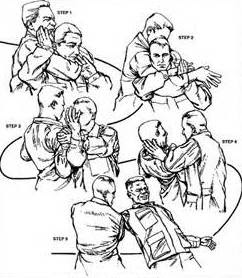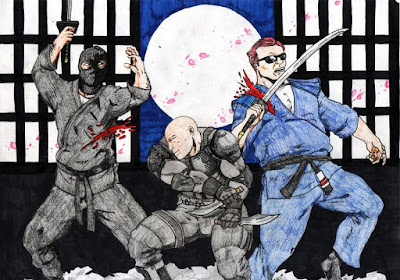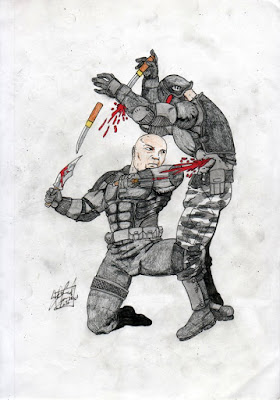DMCA PROTECTED AND MONITORED
© COPYRIGHT – ALL RIGHTS RESERVED. This site is protected and monitored by DMCA.COM - ANY UNAUTHORIZED Reproduction, Duplication, Distribution of any kind is STRICTLY PROHIBITED. All original content is created by the website owner, Barron Shepherd, including but not limited to text, design, code, images, photographs and videos are considered to be the Intellectual Property of the website owner, Barron Shepherd, whether copyrighted or not, and are protected by DMCA Protection Services using the Digital Millennium Copyright Act Title 17 Chapter 512 (c)(3). Direct linking, reproduction or re-publication of this content is prohibited without permission. Under 17 U.S.C section 101 et seq. those who violate the DMCA could be liable for statutory damages as high as 150,000.00 as set forth in section 504(c)(2) therein.
Sunday, February 7, 2016
THE REALITY OF A KNIFE ATTACK: PART 2
Sunday, January 31, 2016
KNIFE FIGHTING
HAND TO HAND COMBAT
 Other combat systems designed for military combat were
introduced elsewhere, including European Unifight, Soviet/Russian Sambo, Army
hand-to-hand fight and Systema, Chinese military Sanshou/Sanda, Israeli Kapap
and Krav Maga. The prevalence and style of hand-to-hand combat training often
changes based on perceived need. Elite units such as special forces and
commando units tend to place higher emphasis on hand-to-hand combat training.
Other combat systems designed for military combat were
introduced elsewhere, including European Unifight, Soviet/Russian Sambo, Army
hand-to-hand fight and Systema, Chinese military Sanshou/Sanda, Israeli Kapap
and Krav Maga. The prevalence and style of hand-to-hand combat training often
changes based on perceived need. Elite units such as special forces and
commando units tend to place higher emphasis on hand-to-hand combat training.Friday, January 29, 2016
WORLD WAR 2 COMBATIVES
 The ninja were for all intent and pruposes were the special
forces operatives of their day and I have always been interested in the special
forces operatives of our day and their history, particularly in close quarter
combat (CQC) and World War II Combatives such as William E Fairbain's Defendu
and many others.
The ninja were for all intent and pruposes were the special
forces operatives of their day and I have always been interested in the special
forces operatives of our day and their history, particularly in close quarter
combat (CQC) and World War II Combatives such as William E Fairbain's Defendu
and many others. |
| Add caption |
Monday, January 25, 2016
COMBAT JUDO: JUDO IN THE MILITARY
Judo from its very beginning has been a self-defense and combat discipline. The original Judo from Jigoro Kano was and still is a full featured combat discipline which formed the basis for many Military and Police tactics around the world. Pre-WWII Judo was a far different thing than what we see now.
(H2H), advanced firearm point shooting methods, and weapons techniques (knife/bayonet/improvised weapons) that were taught to allied special forces in World War II. The most successful programs were offshoots from the British Commando training taught by William E Fairbairn. Farbairn, a second degree black belt in Judo, had trained the police force in Shanghai, China before the war.
In 1952 the Air Training Command took over the program. The Commanding General was General Thomas Power. Because of the deficiency in qualified instructors, Power sent two classes of twenty four Airmen to train at the Kodokan for several weeks.
Based upon the success of this trial and after an official delegation from the Kodokan toured SAC bases in the United States, Bruno set up an eight week training course at the Kodokan. Students trained eight hours a day, five days a week and upon return to the United States were assigned throughout SAC. The course was a Japanese designed mix of judo, aikido, karate and taihojutsu.
Sunday, January 24, 2016
THE REALITY OF KNIFE ATTACKS
Wednesday, January 20, 2016
JUDO'S NINJA
 |
| RYOHEI UCHIDA PHOTO PRVIDED BY UCHIDA FAMILY |
 |
Front row Left to Right: Ryohei Uchida, K. Iizuka, Sakuzo
Uchida, Ikkan Miyakawa. Back Row: Isogai, Nagaoka, Jigoro Kano (seated)
Yoshitsugu Yamashita (taught Pres. Teddy Rosevelt Judo).
|
 |
| UCHIDA FAMILY 50TH ANNIVERSARY OF THE FAMILY DOJO 3rd picture from the right on wall is a portrait of Ryohei Uchida |
Sunday, January 17, 2016
THE TOO REAL REALITY OF A KNIFE ATTACK
Recently a person I know and speak with several times thru the course of most weeks had gotten himself into a physical altercation, At first it was just a fist fight but later almost ended with someone losing their life. Even though this particular incident took place in a bar it still raised some red flags in my mind about the training the majority of martial artist do and if it is even practical and effective in this day and time.
I looked at my friend with the knife wounds all over his back, on both sides of his ribs, his neck and arms and it dawns on me now more than ever. Over my years of training in self defense, and teaching self defense I never saw any system, or style of knife defense that immediately clicked in my head as being effective. I have seen a load of self defense instructors who teach how to analyze the knife from different angles with all these fancy, complicated, and downright ineffective techniques. Some people though seem to buy into them because they LOOK COOL.
We didn’t learn a hundred and something techniques, we didn’t pull guard or fight off our backs. We didn't strike some cool movie Bruce Lee fighting pose. It wasn’t a game it was how we prepared for what would be a life or death situation. A situation for me that keeps it all in perspective.








